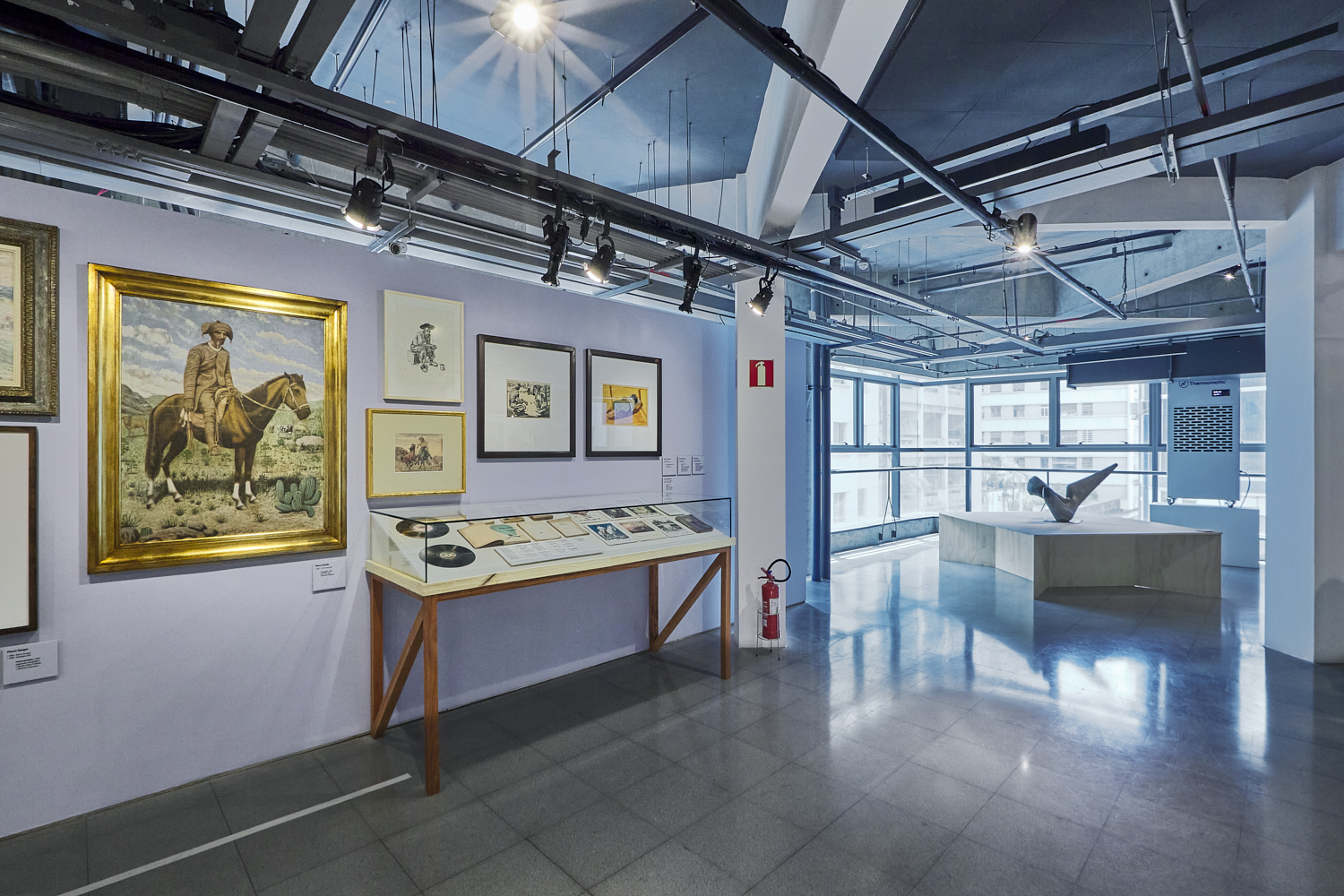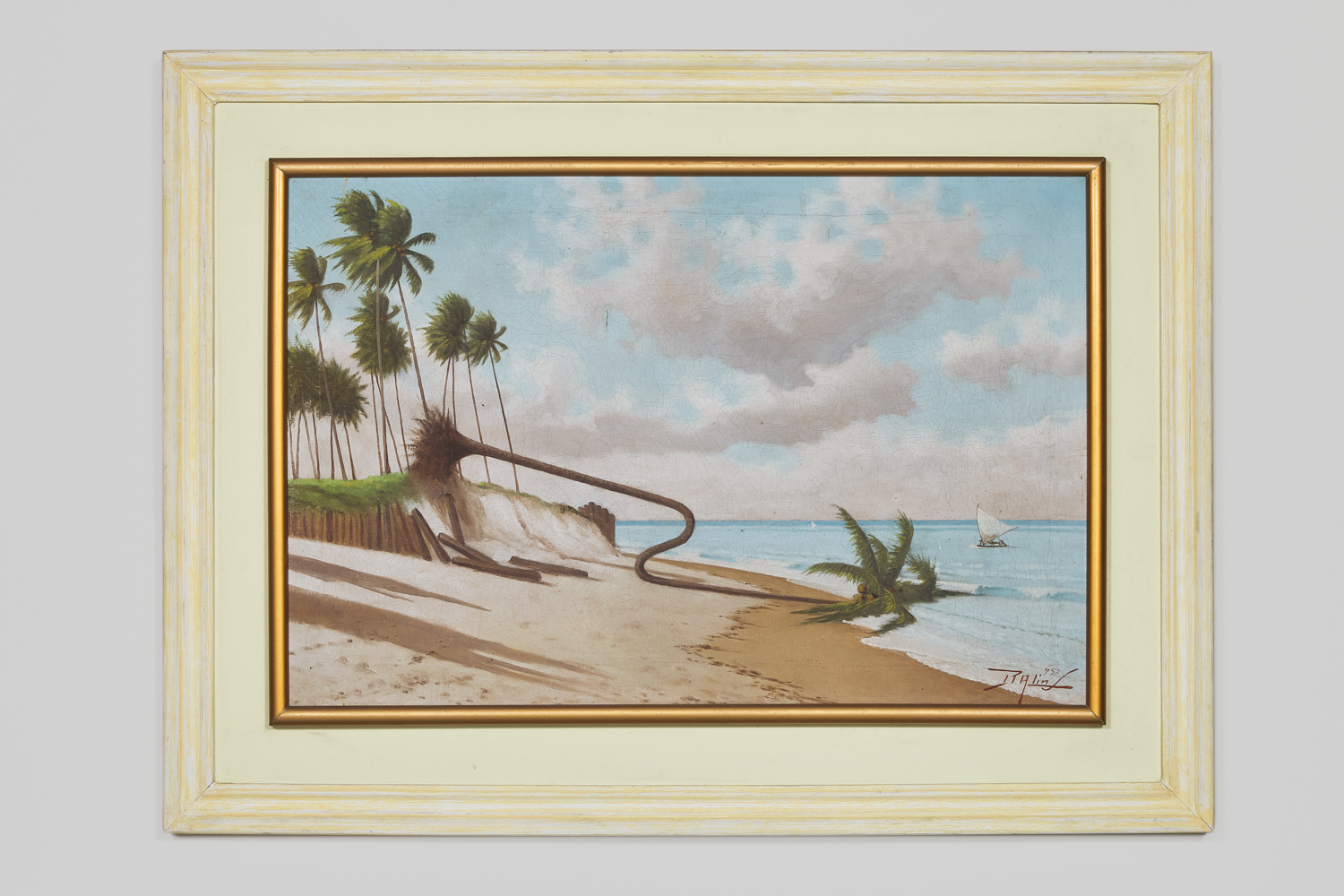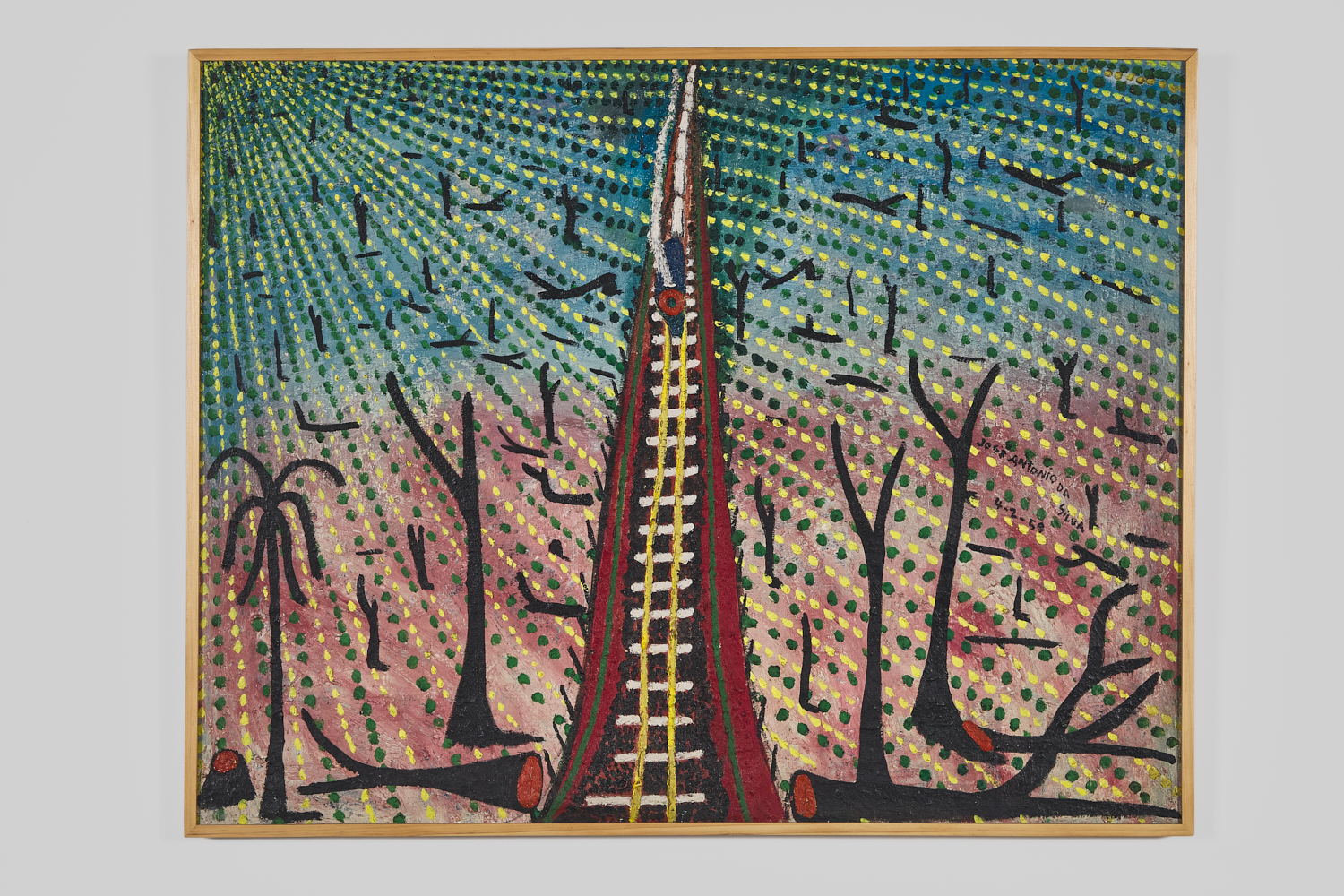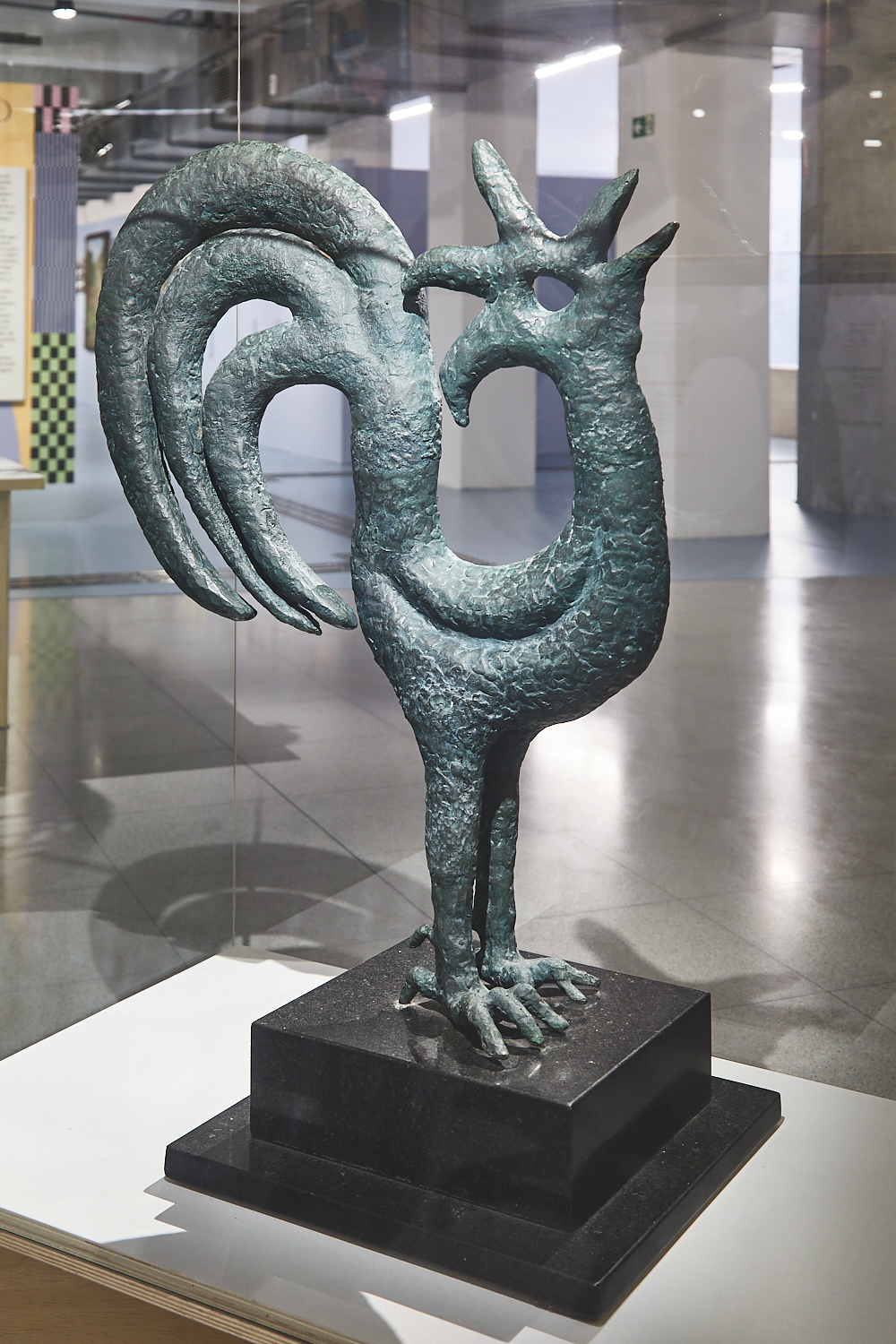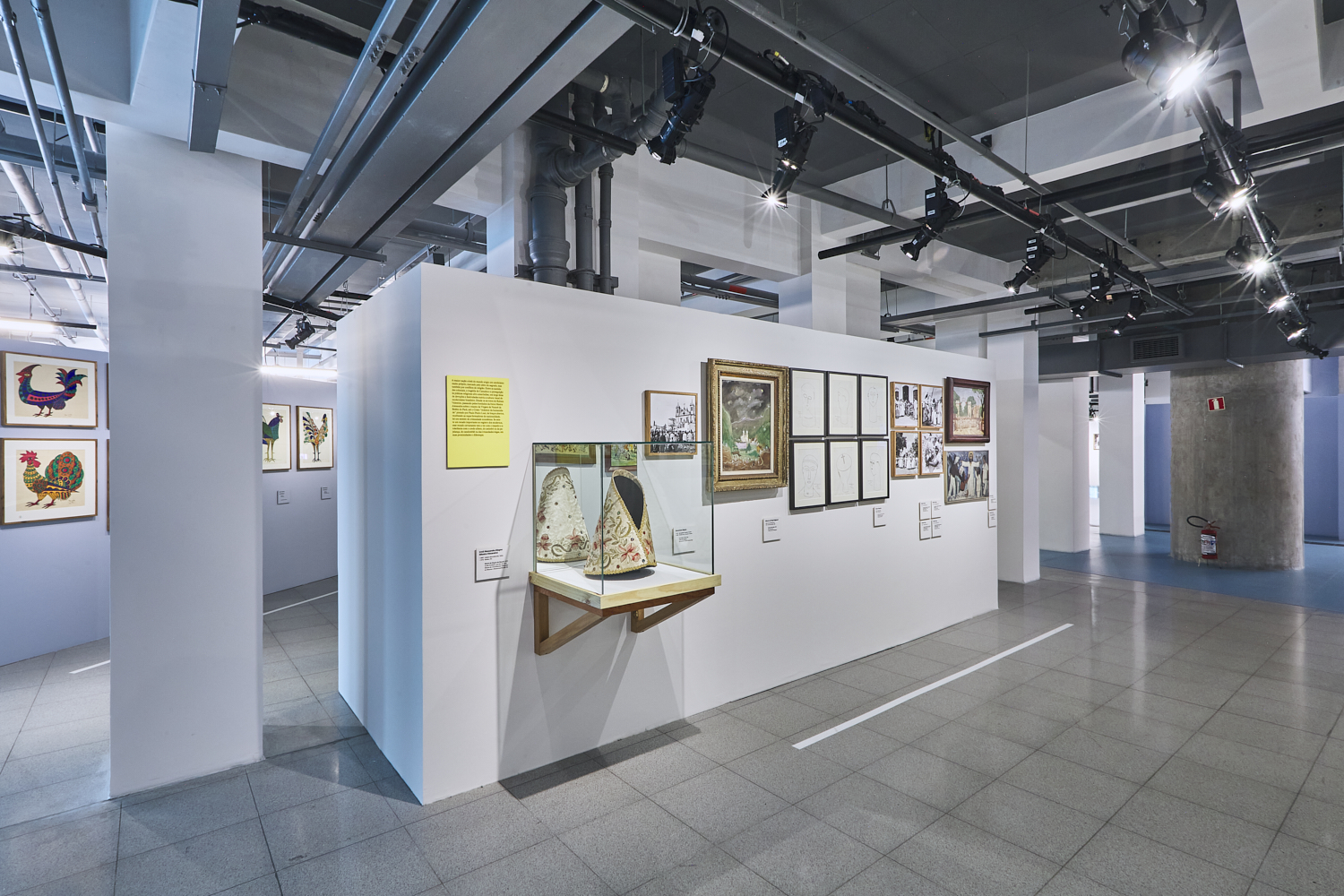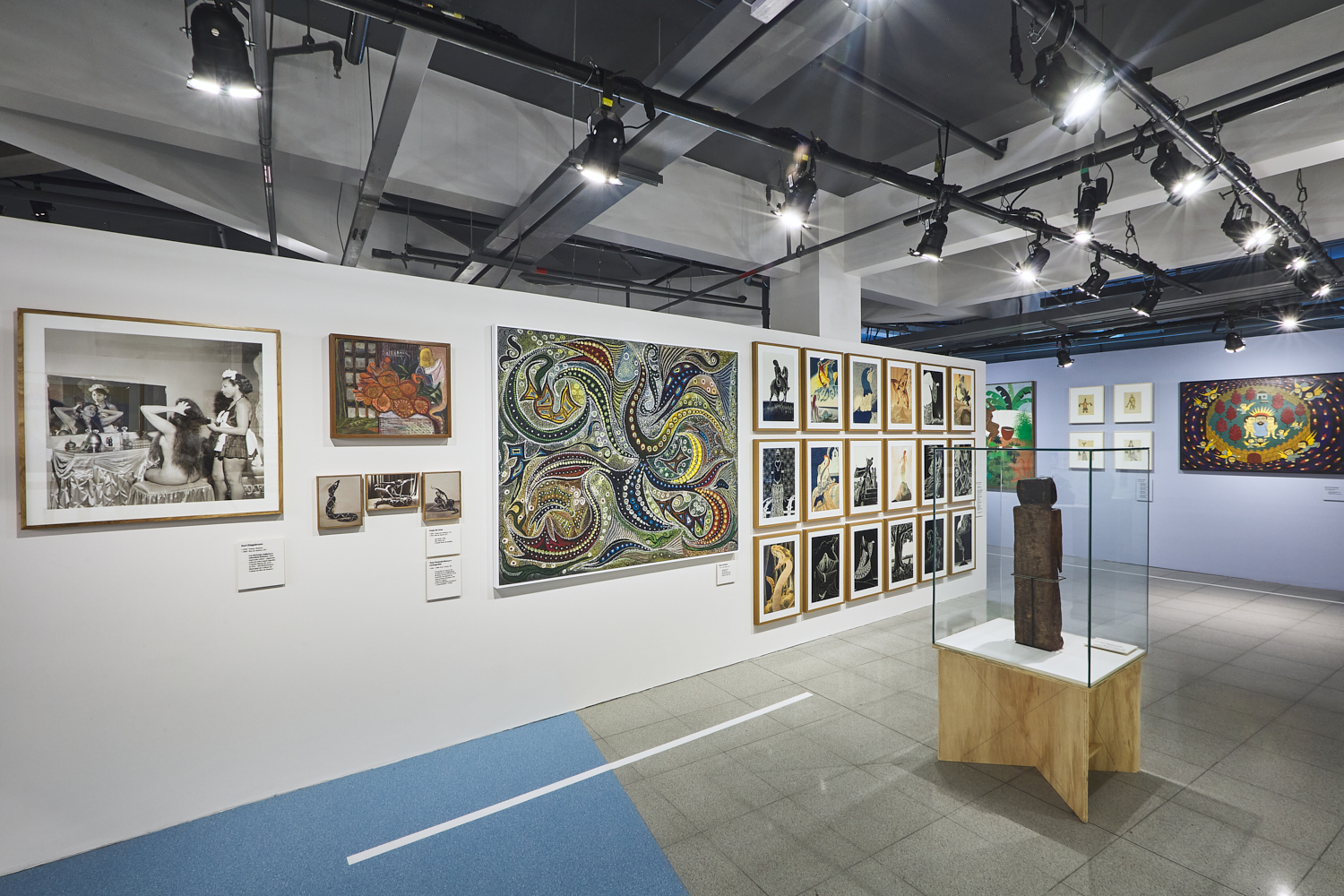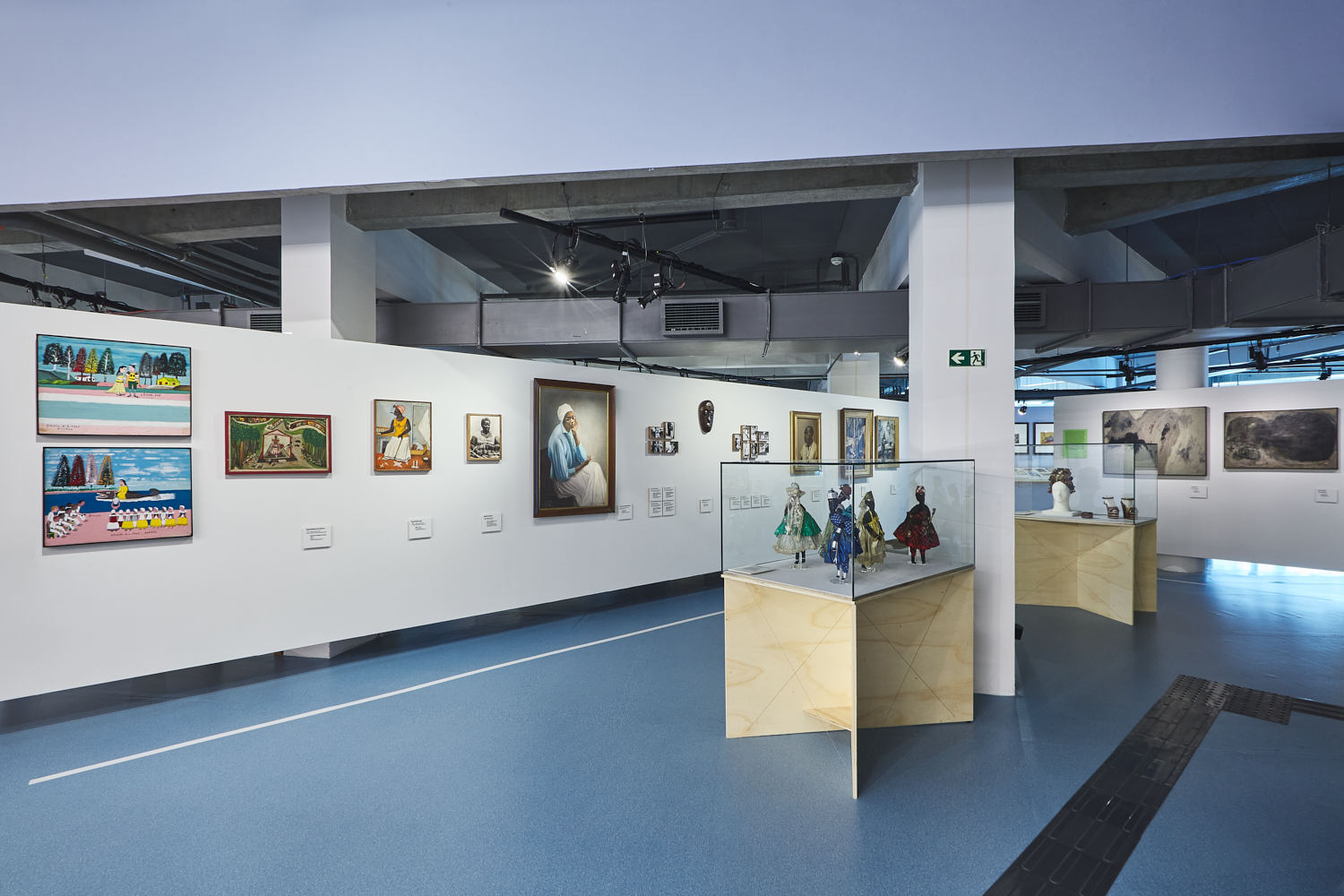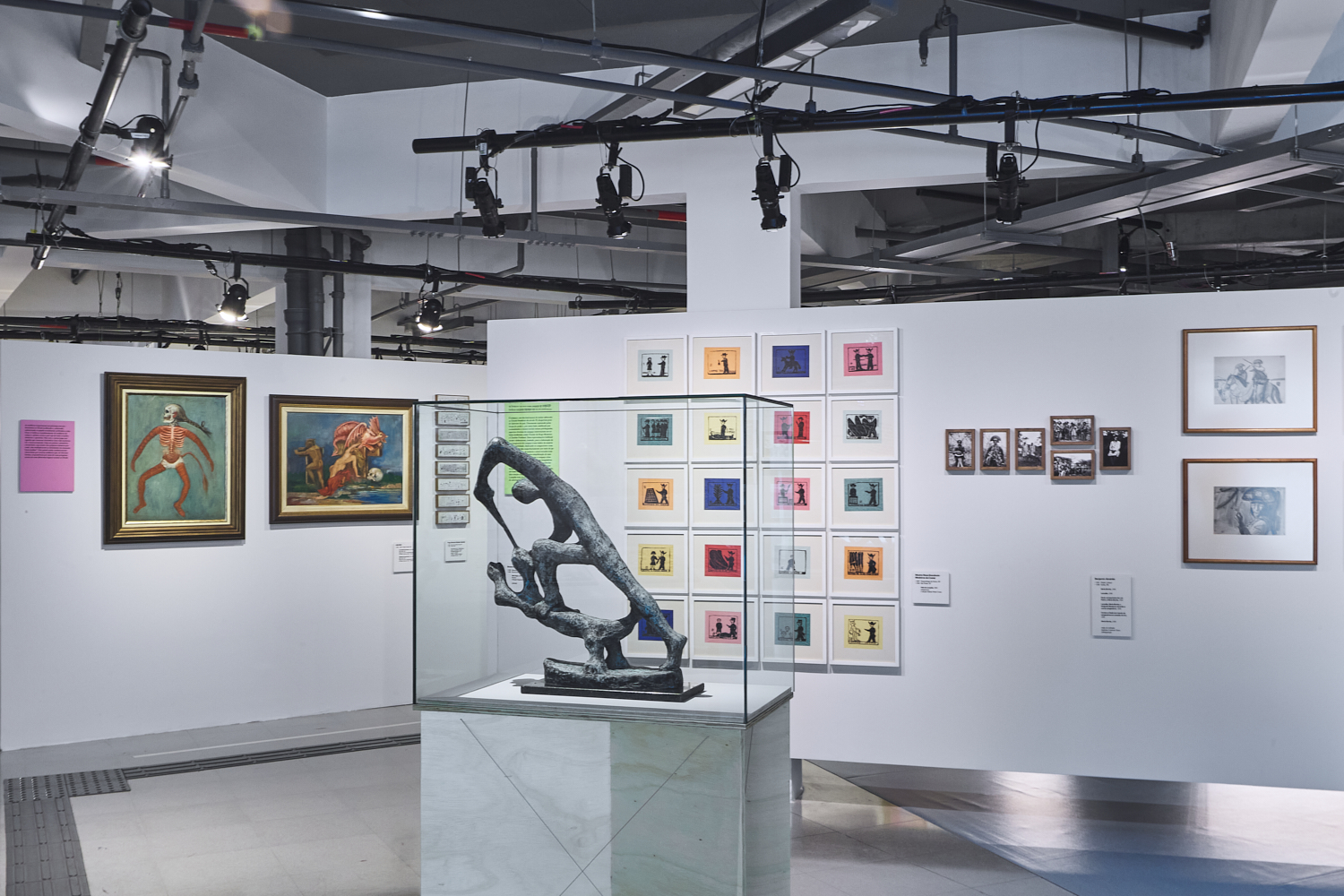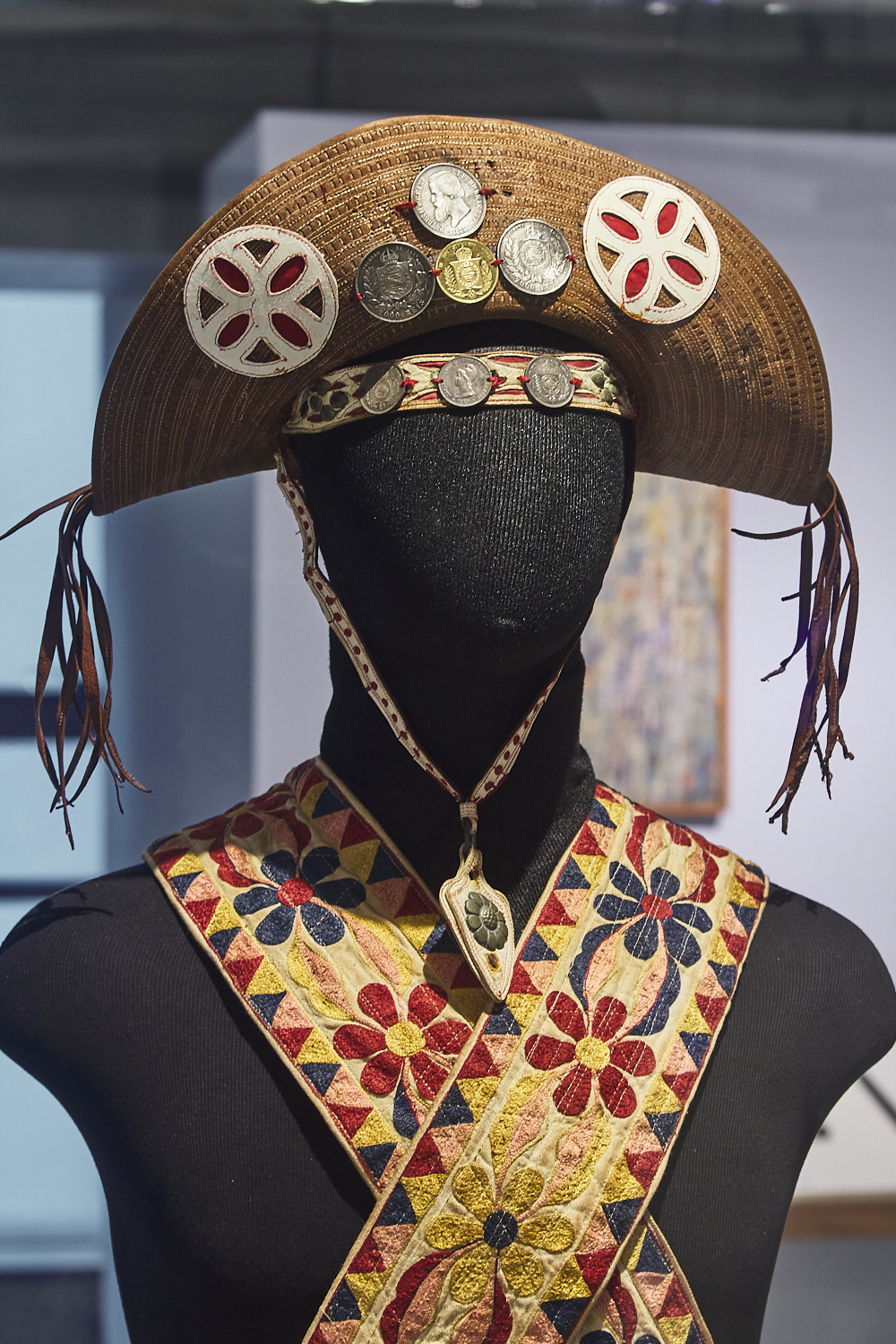the exhibition brings about 600 works by 200 artists, among them are Lídia Baís, Mestre Zumba, Genaro de Carvalho, Anita Malfatti, Tomie Ohtake, Raimundo Cela, Pagu, Alberto da Veiga Guignard, Rubem Valentin, Tarsila do Amaral, Mestre Vitalino.
February 16 -August 7, 2022
From February 16 to August 7, 2022, Sesc São Paulo presents, at its 24 de Maio location downtown, the new exhibition Raio-que-o-parta: ficções do moderno no Brasil. Curated by researchers Aldrin Figueiredo, Clarissa Diniz, Divino Sobral, Marcelo Campos, Paula Ramos, Raphael Fonseca with consulting by Fernanda Pitta, the show is part of a state-wide program by Sesc São Paulo called Diversos 22 – Projects, Memories, Connections, in celebration of the centenary of Modern Art Week and the bicentennial of the national independence of Brazil.
In order to critically reflect on these dates, analyzing them in historical contexts about the modernization of the Brazilian territory, what they symbolized in the past and what they mobilize in the present in a project for the future, the exhibition brings about 600 works by 200 artists, among them are Lídia Baís, Mestre Zumba, Genaro de Carvalho, Anita Malfatti, Tomie Ohtake, Raimundo Cela, Pagu, Alberto da Veiga Guignard, Rubem Valentin, Tarsila do Amaral, Mestre Vitalino, with free entry until August 7, 2022.
The exhibition's title is inspired by an architectural style found on the facades of old houses in the northern city of Belém do Pará. The juxtaposition of broken tiles forming geometric, angled and colorful designs, reminiscent of arrows, boomerangs and lightning bolts are known as “raio-que-o-parta.” This architectural ad was not limited to the local elites of the 1950s, quickly appropriated by other layers of society that popularized the raio-que-o-parta facades in the neighborhoods of Belém (PA, Brazil), as a way of modernizing what was considered obsolete in the arts.
By articulating the notion of modernity with the Brazilian territory, the exhibition Raio-que-o-parta: fictions of the modern in Brazil intends to rethink the centrality of the 1922 event that marked Brazil’s history of art, through an expansion that was not only chronological, but also geographical. It is a project that aims to show the public that modern art was already being discussed by many artists, intellectuals and institutions across the country, from the late 19th century to the mid-20th century.
The exhibition also intends to expose the different types of languages and ways of creating and sharing images of the period. In addition to drawings, paintings and sculptures, the project brings important examples of photography, film, illustrated magazines, music and documented actions that are essential to broadening the understanding of the many modernities present in Brazil.
For the director of Sesc São Paulo, Danilo Santos de Miranda, the institution holds this exhibition within the scope of its state-wide program Diversos 22 – Projects, Memories, Connections, which puts on the agenda not only the Modern Art Week of 1922, but also the Independence of Brazil in 1822. “Reflecting on these milestones implies bringing them up to date with the urgencies of the present; hence the search for contemplating what goes beyond the São Paulo setting, making other legacies visible. The main issue pervades the construction of perspectives that make it possible to think about the country in a more diverse and complex way, with its contradictions and strengths, pouring them into propositional resources.”
The exhibition, therefore, certifies to the public that the notion of modern art in Brazil is as diverse as the multiple cultures, accents and narratives that make up a country of continental dimensions. To this end, the work of the seven researchers and curators in the exhibition was divided into four sections, proposing a historical and social immersion in Brazilian modern art. The title of each nucleus, as well as the exhibition itself, alludes to the artistic manifestations existing in the country.
First Section - Deixa Falar [Let Them Talk]
Themes such as identity and empowerment are highlighted in this section which makes reference to the samba school of the same name, created in the late 1920s, in Rio de Janeiro. In Brazilian modernity, this debate is full of ambiguities. While the presence of characters and manifestations of native peoples, Afro-Brazilians and immigrant minorities was central to the creation of an idea of modern art, it often appeared through the eyes of an elite that observed the people, silencing their voice, in addition to destroying their places of resistance, such as forests, villages, quilombos and tenements, with the pretext of promoting a misguided idea of modernity. In this space, the public will find works by Afro-Brazilian artists, such as Mestre Zumba, Agnaldo Manoel dos Santos and Wilson Tibério, in addition to Tomie Ohtake, Carybé, Benjamin Abrahão, Anita Malfatti, Haruo Ohara among other artists.
Second Section - Centauros Iconoclastas [Iconoclastic Centaurs]
A reference to the literary group Centauros Iconoclastas, founded in Recife during the 1920s. Its name points to one of the modern emphases of art produced in Brazil: on the one hand, the interest in forms of existence that go beyond the human and “pure reason,” on the other, the questioning of the authority of sacralization, a skepticism of orders and hierarchies imposed on images and senses. Between centaurs and iconoclasms, we thus see the emergence of a thriving production that investigates the multiple possibilities of bodies, humanities, animalities, myths, and metamorphoses. Approaching psychoanalysis, some artists sought another fertile territory of performativity. In this process of approximation between art and madness, they criticized normativity through a supposedly correct way of being, claiming the radical diversity of existences. This section features works by Pagu, Lídia Baís, Aurora Cursino dos Santos, Tarsila do Amaral, Joaquim do Rego Monteiro, Moacir Andrade, Nelson Boeira Faedrich and others.
Third Section - Eu vou Reunir, Eu vou Guarnecer [I will Gather, I will Garnish]
A reference to partying as a space of freedom and the first window of modernism. The idea of gathering and forming a group is the second path of the moderns. “Eu vou reunir, eu vou guarnecer, meu boi vai rolar no terreiro” [I will gather, I will garnish, my ox will roll in the terreiro], say the verses of a traditional song in bumba-meu-boi festivities, in the north of the country. Artists who sought creative autonomy in novels and canvases saw in the participants of traditional games and cordões, a path to the new, of the feeling of identity of the village and the metropolis. It is as if we were, through party and melancholy, reviewing some of the main predicates of national modernism, including an immense utopia for the informal, spontaneous and relaxed voice of the streets. Emboladas and cordéis, carimbós and batucadas expanded the verses of a metrics so often dreamed of. In this section, works by Dimitri Ismailovitch, Djanira, Heitor dos Prazeres, DJ Oliveira, Franklin Cascaes, Eros Volúsia, Rubem Valentim, Lasar Segall and other artists expose the context of this celebration that is intertwined with melancholy.
Fourth Section – Vândalos do Apocalipse [Vandals of the Apocalypse]
The title of this last section refers to the literary group formed by writers from Pará, Vândalos do Apocalipse, such as Bruno de Menezes, Luiz Teixeira Gomes (Jacques Flores) and Clóvis de Gusmão, who criticized the discourses of modernization and the parameters of progress and development in force in the country from 1921. The contradictions and conflicts of modern Brazil generated in the encounter between the colonial heritage and the project of national modernization, mainly in the capitals, after the establishment of the Republican regime, were provoked by the successive attempts at occupying immense areas considered until then as demographic voids and unproductive land. The arrival of “progress” promoted the destruction of nature and traditional ways of life, in addition to contributing to the increase of the homeless class, due to the expulsion of rural workers from their places of origin. In this section, which recounts and resumes the discussions about the true Brazilian national identity, engendered in colonial tradition and territorial modernization, are the works of José Antônio da Silva, Hildegrand Rosenthal, Alice Brill, Frei Cândido Penso, Branco e Silva, among other national names.
These four sections challenge the canonical version of a modernity centered around São Paulo. If lightning must hit, according to the title given to the exhibition, let it be to shed light on the different fictions of modernity, offering the public a diverse and heterogeneous context of Brazilian modern art.
The works that make up the exhibition space, with around 1,300m², were donated by more than 100 Brazilian institutions and collectors, among them the Pinacoteca do Amazonas, the MAMAM in Recife, the Museu Nacional de Belas Artes, MAC-USP, the MAR-RJ, MASP, Pinacoteca do Estado de São Paulo, Museu de Art do Rio Grande do Sul, Museu de Arte de Belém, Museu Antropológico da UFG and the Museu de Arte da UFSC.
In the exhibition space at Sesc 24 de Maio, virtual and in-person educational activities will also be offered with art-educators and researchers who are in constant dialogue with Brazilian artistic production. The exhibition will feature accessibility resources, such as audio description, a video-guide in Libras (Brazilian Sign Language), as well as tactile resources and texts translated into Portuguese, English and Spanish.
About the curatorial team
Aldrin Moura de Figueiredo is a historian, with a PhD in history from UNICAMP, professor at the Federal University and director of the Museu do Instituto Histórico e Geográfico do Pará, member of the Editorial Board of the Federal Senate and researcher associated with João Lúcio de Azevedo (Instituto Camões and UFPA). He published, among other works, Os vândalos do Apocalipse e outras histórias: arte e literatura no Pará dos anos 20 (Belém: IAP, 2012).
Breno de Faria is an art historian and doctoral student at PGEHA-MAC/USP. He holds a master's degree in art history from UNICAMP and a bachelor's degree in history from UFMG. His research is on collections, cultural heritage and art history in Brazil. He has developed work and research in museums such as MAP, MCSP, MAR and MASP.
Clarissa Diniz is a curator, writer and educator, with a master's degree in art history and criticism from UERJ and a professor at the Escola de Artes Visuais do Parque Lage. She was editor of Revista Tatuí (2006-2015) and content manager of the Museu de Arte do Rio - MAR (2013-2018), where she developed projects such as Do Valongo à Favela imaginário e periferia (2014), Pernambuco Experimental (2013), Dja Guata Porã - Rio de Janeiro indigéna (2017) and Rio do Samba: reinvenção e resistência (2018).
Divino Sobral was born in Goiânia (GO), where he lives and works as an artist, art critic and independent curator. Between 2011 and 2013 he directed the Museu de Arte Contemporânea de Goiás. He received awards in the curatorial field and in critical writing, such as the Marcantonio Vilaça Award (2015) and the Situações Brasília Award (2014). He is a researcher in the areas of contemporary Brazilian production and Goiás modernism.
Ludimilla Fonseca is dedicated to curatorial practices and art history research. Among the exhibitions she has worked on are: Vaivém (CCBB 2019/20), Dura Lex Sed Lex (Bienal Sur 2018) and Bestiário (CCSP 2018). She is a master's student in visual arts at UFRJ (CAPES research fellow) and conducted postgraduate research in the "History and Culture of Perfume" at FASM-SP. She also studied journalism at UFJF and works with communication strategies for artistic and cultural projects. She is Currently part of Kura - Art Advising, in São Paulo (SP).
Marcelo Campos is an associate professor at the department of art history and theory at the Instituto de Artes da UERJ and at the graduate programs in arts (PPGArtes) and art history (PPGHA). Chief curator of the Museu de Arte do Rio. He earned a PhD in Visual Arts from the PPGAV at Escola de Belas Artes da UFRJ. He is the author of the book Escultura Contemporânea no Brasil: reflexões em dez percursos (2016). Curator of several exhibitions, such as “Crônicas Cariocas” (2021), with Amanda Bonan, Conceição Evaristo and Luiz Antônio Simas, at MAR; “Casa Carioca” (2020), with Joice Berth at MAR; “À Nordeste” (2019), with Bitu Cassundé and Clarissa Diniz at Sesc 24 de Maio; “O Rio do Samba: resistência e reinvenção” (2018), with Nei Lopes, Evandro Salles and Clarissa Diniz, at MAR.
Paula Ramos is a critic, art historian and curator, associate professor at the Instituto de Artes at UFRGS, working at the undergraduate and graduate levels in art history. Her research is focused on modernism in southern Brazil, with an emphasis on the relationship between visual arts and graphic culture. She is the author of the books "A madrugada da modernidade (1926)” and “A modernidade impressa – Artistas ilustradores da Livraria do Globo – Porto Alegre,” which was awarded several prizes, such as the Jabuti literary prize.
Raphael Fonseca is a curator, art historian, critic and educator. He earned a PhD in art history from UERJ. From 2017 to 2020, he worked as curator of the Museu de Arte Contemporânea de Niterói. He is currently working as a curator of modern and contemporary Latin American art at the Denver Art Museum (USA). Among his recent projects are Sweat (Haus der Kunst, Munich, Germany, 2021) and Vaivém (Centro Cultural Banco do Brasil, 2019-2020).
Renato Menezes is a PhD candidate in art history and theory at EHESS, Paris, France. He has a master's in history from UNICAMP and a bachelor's in art history from UERJ. Between 2020 and 2021 he was a graduate intern in the curatorial department of the Getty Research Institute. He co-organized the book França Antártica: Ensaios Interdisciplinares. His research focuses on the study of visual culture and artistic literature of the modern era, between Europe and Latin America.
About Diversos 22
Diversos 22 – Projects, Memories, Connections is a state-wide program by Sesc São Paulo, in celebration of the centenary of the Modern Art Week of 1922 and the bicentennial of the national independence of Brazil in 1822, with artistic and socio-educational activities, virtual and in-person programs in the different Sesc locations in the capital, countryside and coast of the state of São Paulo, with the objective of marking a temporal arc that evokes celebrations and reflections around different themes, but integrated and in dialogue with each other, around projects, memories and connections related to the ephemeris, to discuss, deepen and resignify them, in the face of present-day challenges. The program began in September 2021, with the event Seminário Diversos 22: Levantes Modernistas and will run through December 2022. More information available on sescsp.org.br/diversos22.
About Sesc São Paulo
With 75 years of experience, Sesc – Serviço Social do Comércio has a network of 45 operational units in the state of São Paulo and develops actions with the objective of promoting well-being and quality of life for workers in commerce, services, tourism and for all of society. Maintained by businessmen in the sector, Sesc is a private entity that works in physical-sports, environment, health, dentistry, social tourism, arts, food and food safety, inclusion, diversity and citizenship. The institution's initiatives start from the cultural and educational perspectives aimed at all age groups to contribute to more lasting and meaningful experiences. Around 30 million people are attended at the units in the state of São Paulo per year. Today, approximately 50 national and international organizations in the fields of arts, sports, culture, health, environment, tourism, social services and human rights have representatives from Sesc São Paulo in their consultative and deliberative bodies. More information available on sescsp.org.br/sobreosesc.

